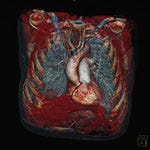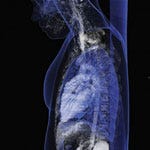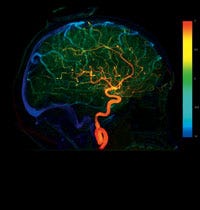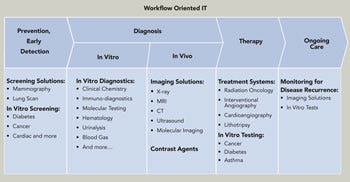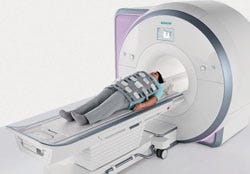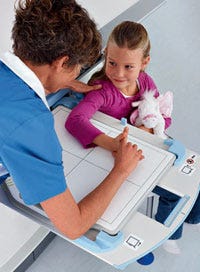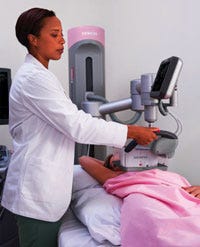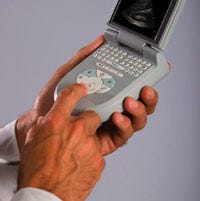The ARTISTE Solution provides a comprehensive portfolio of image-guided and advanced treatment delivery tools to adapt to each patient’s needs.
October 28, 2010
Siemens is recognized for its advances in the integration of imaging technologies and as a leader in the development of technologies that reduce radiation exposure from computed tomography (CT). The global company reached that position because imaging technology is not only at the heart and soul of the company—it's at the heart and soul of its people. More than 48,000 employees work for the company's worldwide healthcare business.
The imaging giant began its work on radiation dose reduction in the early 1990s when the concern over possible excessive dosing came to the forefront in other parts of the world. But the company’s focus on the problem was accelerated in recent years “because the way in which CT was being used began changing,” says Tom Miller, CEO of Siemens Healthcare’s Customer Business Unit. As CT technology became increasingly used to rule out disease in the United States, reducing the amount of radiation became a more important consideration, he says.
Moreover, says Miller, Siemens is a technology company. "Every photon contributes. You can always make a better device. It can be faster, higher resolution, or lower dose. He points to the company's recent launch of a program that focuses on advancing technologies and promoting education to the healthcare community on reducing CT radiation exposure. Through its Siemens Radiation Reduction Alliance (SIERRA), the company has established an expert panel to generate proposals for dose reduction in CT. Among its objectives are identifying ways for manufacturers to develop their technologies and to educate users on how to better adapt their procedures to improve dose reduction. The panel includes 15 specialists in radiology, cardiology, and physics.
|
|
|
Images captured on the SOMATOM Definition Flash CT (top and middle) and the Biograph PET-CT systems (bottom). |
Miller says that the idea behind the initiative is to balance image quality with the need to keep a patient’s radiation exposure as low as possible. With SIERRA, Siemens has taken a clear leadership role in this field, working to reduce radiation exposure for all typical CT examinations below 2 mSv.
Recent incidents at several California hospitals prompted California to pass a law requiring radiologists to incorporate radiation dose levels in their reports. The measure calls for radiologists to include the dose length product or the CT dose index if the machine is able to calculate it. Other states will likely follow California’s lead. Miller says that such measures and initiatives are not necessarily bad, but he cautions that they may shift control away from manufacturers. In addition to its SIERRA program, Siemens worked closely with the Medical Imaging and Technology Alliance to ensure that the technology capabilities were fully understood. Siemens is also working to develop standards for training and education for hospital and imaging facility personnel.
Siemens Healthcare’s latest dose-reduction technology, the Iterative Reconstruction in Image Space (IRIS), aides in the reduction of image noise without the loss of quality or detail visualization. The significant noise reduction provided by IRIS allows for up to a 60% radiation dose reduction in routine clinical use. “The efficient use and collection of information enables us to reconstruct and differentiate the signal from the noise more effectively,” says Miller. “If we can reconstruct it more effectively, we can amplify the signal. We can further reduce the dose needed and reduce time.”
The People Behind the Technology
Executives at Siemens are in healthcare technology for life, explains Miller. "We know how the technology works," he says. The reason? The majority of Siemens executives are engineers and physicists themselves. "We take our roles in developing the technology very seriously, and we are deeply involved with the equipment. We are all engineers who are narrowly focused on a subset of the technology or on the study of a particular disease."
Miller himself is a great example. For more than 25 years, Miller, who holds a degree in nuclear engineering a master’s from Harvard Medical School and MIT’s joint program in medical physics, started his Siemens career in 1982 as a product specialist with the Computed Tomography Business Unit. In 1997, he took the helm of Carl Zeiss, Inc. He also cofounded LightLab Imaging, a company that commercialized a new diagnostic imaging method called optical coherence tomography (OCT). After the sale of LightLab, he returned to Siemens, where he ran the business development function for healthcare and later managed the health services business unit of Siemens Healthcare. He joined the group executive management board of the healthcare sector in 2006.
|
The syngo iFlow provides a greater understanding of the contrast flow within the pathology. |
Miller's entire professional life has been dedicated to the development of imaging technologies. He recently testified before Congress in an effort to dispel myths surrounding the use of imaging for diagnosis. As he summed up his points, his passion was clear—and personal:
Diagnostic technologies support more cost-effective care by enabling earlier, faster, and more-accurate diagnosis, eliminating the need for expensive and invasive surgeries and inappropriate therapies, reducing hospital admissions, and, in many cases, avoiding costs of long-term chronic conditions.
The growth in medical imaging can be attributed to its transformational effect on medicine for almost every facet of every disease. Physicians know that medical imaging is simply the best tool they have to diagnose disease with confidence. And, the great majority of physicians have one overriding interest: to achieve the best possible outcomes for their patients.
The best means to reduce costs and overuse is by creating a more-efficient healthcare system through healthcare information technology and to manage medical imaging utilization through physician-driven appropriateness guidelines.
Advanced diagnostic imaging technologies don’t just improve health—they save lives. Simply ask any woman whose mammogram detected breast cancer in its earliest stages to make her a survivor. Ask anyone whose coronary CT angiography found blocked arteries before he/she suffered a catastrophic—or fatal—heart attack. Or ask my father, who, after suffering a stroke, can now still converse with his grandchildren due to immediate access to critical diagnostic imaging technology.
|
Tom Miller, CEO of Siemens Healthcare’s Customer Solutions, is passionate about healthcare and has dedicated his career to developing the full potential of medical technology. |
From Dose Reduction to Improved Work Flow
Siemens recently announced the next release of the ACUSON SC2000 volume imaging ultrasound system. "The ACUSON SC2000 integrates three different technologies. With ultrasound, the outcome is very user dependent, and the outcome can be slightly different each time. This uses a different work flow with as few steps as possible with the goal of ensuring consistency of quality for tests." Miller notes that ultrasound is the medical imaging technology requiring the most action and intervention on the part of the technician. "The work flow allows greater consistency but also reduces repetitive stress injuries to the technician," he says.
The system offers work flow improvements in conventional and real-time volumetric echocardiography. Manual measurements require time-consuming repetitive key strokes, which actually consume the majority of the exam time. This system provides semiautomated measurements for routine echo exams, decreasing scan time by 10–15 minutes per patient. The company says the system's protocols dramatically reduce the need for user interaction and the number of key strokes during the imaging process.
|
Siemens Healthcare’s portfolio addresses the entire healthcare continuum. |
Prospering in a Tough Economy
Siemens responded quickly to the economic crisis. In July 2008, as part of a massive global restructuring, Siemens AG announced would cut a number of jobs from its healthcare unit, mostly in the United States. That helped the company remain strong through the economic downturn and maintain its commitment to its R&D efforts, says Miller.
"At this point, we are back in a growth initiative. That could not have happened without some restructuring. The growth we are seeing, though, is primarily in India, China, and the Middle Eastern markets," says Miller. "We are starting to see some regrowth in the United States, and we are rehiring." Most significant is that Miller says the company did not decrease its investment in R&D. "During this time, we treated R&D as sacred," he says. "We knew the crisis would not last forever, and we protected that [investment]."
|
MAGNETOM Aera MR scanner is the first 1.5 T system with total imaging matrix 4G technology and Dot (day optimizing throughput) engine. |
Earlier this year, Siemens restructured its healthcare unit. Siemens Healthcare increased second quarter income year over year (to $651.5 million from $470.1 million), but it reported a slight decrease in revenues ($3.93 billion) in the second quarter, compared with $3.95 billion in the same quarter in 2009.
With the restructure, Siemens combined its imaging and therapy systems (angiography systems, linear accelerators, particle therapy systems, etc.) with large-scale diagnostic imaging and therapy devices such as CT, MRI, and PET systems. Bernd Montag is CEO of the new group. Norbert Gaus is CEO of clinical products, which includes ultrasound products as well. Diagnostics, which includes equipment and reagents, is headed by Michael Reitermann. Miller became the CEO of the new customer solutions unit.
According to the company's Interim Report for the first nine months, the healthcare sector "showed strong growth in profit, revenue, and orders in a more favorable market environment." The report notes that third-quarter profit rose to €506 million ($706.27 million) on higher revenue and strong execution, including continued cost discipline.
|
Ysio is a highly flexible digital radiography product that can be adapted to the patient and clinician’s needs. |
Siemens says its third-quarter orders for healthcare climbed 18%, with revenue increasing by 10%. Orders came in higher in all three geographic regions compared with the same period in 2009, while revenue rose in Asia, Australia, and the Americas.
The Effects of Healthcare Reform
Miller says that the recent healthcare reform measures will not significantly change what Siemens does and how the company develops its products. "The only area that will be affected is the company's IT space for which we provided meaningful use criteria," he says. He is strongly in favor of comparative effectiveness initiatives, because, he says, these criteria will clearly play a role in technology. "There is one caveat: [comparative effectiveness] may create a dip in the acceptance of technology while people figure out what to do," he says. "But there is nothing wrong with comparative effectiveness. It is important to take the long view."
Imagining the Future of Imaging
|
The ACUSON S2000 Automated Breast Volume Scanner acquires full-field sonographic volumes of the breast. |
"Medical imaging is such an exciting field," says Miller. When he says it, you can hear the excitement in his voice. As he talks about where imaging is headed in the future, he says it is difficult to point to just one significant trend. "The trends that are most exciting to me change from day to day. Today, the continued integration of technology is showing much promise," he says, citing the advances in MR-PET, an area that Siemens is pursuing as "a work in progress." MR and PET systems in combination enable images to be seen that have never been seen before simultaneously.
|
At 1.6 pounds, the ACUSON P10 is the first pocket ultrasound device. |
Another area showing promise, he says, is functional MRI, which can enable advances in diagnostics for diseases such as Alzheimer's, depression, and what he calls other “societal burdens” that are emerging with the aging population. He says the integration of imaging with therapies to provide more minimally invasive options is also emerging as a major trend. "Integrating imaging with the therapy enables patients to leave the hospital faster than ever before," he says. "While there is a big technology investment up front, it decreases costs over the long term."
The Result is Clear
From the integration of imaging technologies to its dedication to dose reduction, Siemens Healthcare is clearly a leader in its pursuit of advancing technologies that improve the diagnosis and treatment of patients.
"The reason Siemens has attained its leadership position is twofold," says Miller. "We have a deep value system in which we foster an attention to the detail of the technology, and we work closely with our customers to understand the clinical trends. We are willing to listen and we implement what we have heard."
About the Author(s)
You May Also Like
